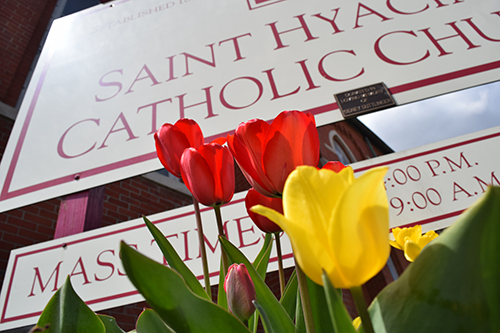Katie Faley: Marveling at glimpses of God’s majestic beauty in a spring garden

Tulips bloom outside St. Hyacinth Church in LaSalle. Columnist Katie Faley says "when the tulips, lilies, and daffodils pop up on their own around Easter . . . it's an easy reminder that, with Jesus, we die and rise with new life." (The Catholic Post/Tom Dermody)
Cause of Our Joy / By Katie Faley
The sunny days we have had these last few weeks have me feeling ready to shake off the winter blues. As ambivalent as I can feel about winter when it lingers around a little too long, I am very thankful that I live in an area with all four seasons. There is something so spiritually nourishing about living in a place with both a summer and a winter.
It never fails to take me by surprise when the tulips, lilies, and daffodils pop up on their own around Easter. It’s such an easy reminder that, with Jesus, we die and rise with new life, just like the trees and grass each year.
So, in the midst of my reflection on the theological symbolism of nature and creation, and with this week marking the celebration of Earth Day, I found myself remembering one of the most beautiful home gardens I have ever seen.
EVERY PLANT POINTED TO GOD
A couple of years ago, during my final summer of grad school, one of my theology professors invited our class over to his home for a Fourth of July party. His large backyard was full of different gardened areas. He humbly explained the meaning of each plant and flower, all blooming quite impressively. I felt like I should have had to pay admission to enter such a grand garden. As he went from plant to plant, he gave us the explanation for why he included each one in his garden.
The theology of a garden very overtly points to God. The ecosystem of a garden reminds us that we are part of a greater creation. Things such as plants and flowers are integral to the thriving of so many other tiny lifeforms.
It was clear that every part of the garden was meant to bless God. I went around the grounds a couple of different times, just to be sure I didn’t miss anything. At each turn, I marveled at how perfectly everything pointed back to God.
What I remember most was the one blooming white lily growing next to a statue of St. Joseph. It was sort of off to the side, separated from the rest of the garden. It was simple and humble — just like St. Joseph.
OUR HEARTS AND PRAYERS GROW, TOO
It makes sense why my professor would turn his entire backyard into a prayer. The theology of a garden very overtly points to God. The ecosystem of a garden reminds us that we are part of a greater creation. Things such as plants and flowers are integral to the thriving of so many other tiny lifeforms.
In the massive existence of creation, we are so tiny. We can accomplish nothing without our creator. Just like the flowers in our garden would die without our attention, regular watering, and careful planning, we would not survive without the care of our Creator.
Gardens also remind us that beauty begets beauty, and we are offered glimpses of God’s majestic beauty through His creation. We see it in the vibrance of the colors and smell it in the fragrance of blooms. God’s imprint of beauty is left in every single thing He creates, not least of these is humanity’s creation. A prayerful garden inspires us to marvel at the immense beauty of the earth, our own creation, and, above all, the beauty of God.
When we care for a garden, we are reminded of the great responsibility that we have been given by God to assist in and care for His creation. It’s been six years since Pope Francis’ encyclical “Laudato Si (On Care for Our Common Home)” came out, but the urgency and simplicity of the Holy Father’s message is still as relevant. He writes, “If we approach nature . . . without this openness to awe and wonder, if we no longer speak the language of fraternity and beauty in our relationship with the world, our attitude will be that of masters, consumers, ruthless exploiters. . . . By contrast, if we feel intimately united with all that exists, then sobriety and care will well up spontaneously.”
When we show our care for even the tiniest of God’s creation all for the glory of Him, that heart of caring grows within us.
I’m no gardening expert. I’m not even a gardening novice, but I hope one day to have a garden as beautiful, flourishing, and prayerful as my professor’s. If you are plating a garden, or attempting to keep just one plant alive — like I will most likely be doing this spring — think of it as a little prayer to bless and glorify God for all of His beauty and goodness.
—
KATIE FALEY is a member of St. Mark Parish in Peoria and digital marketing coordinator for the National Shrine of St. Elizabeth Ann Seton. She has a master’s degree in theology and theological studies from the University of Notre Dame. Write to her at katiefaleywriter@gmail.com.
.






